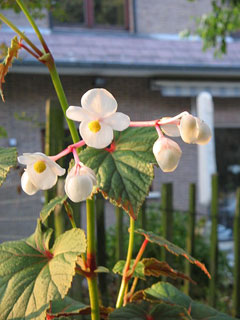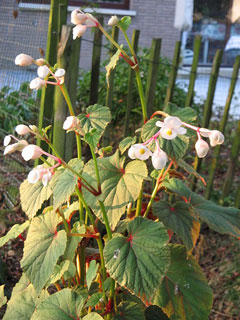 |
|
http://commons.wikimedia.org/wiki/User:Meneerke_bloem |
 |
| http://commons.wikimedia.org/wiki/User:Meneerke_bloem |
Translate this page:
Summary
Bloom Color: Pink, White.
Main Bloom Time: Early summer, Late summer, Mid summer. Form: Spreading or horizontal.
Physical Characteristics

 Begonia grandis is a PERENNIAL growing to 1 m (3ft 3in) at a medium rate.
Begonia grandis is a PERENNIAL growing to 1 m (3ft 3in) at a medium rate.
See above for USDA hardiness. It is hardy to UK zone 6. It is in flower from July to August, and the seeds ripen from August to September. The species is monoecious (individual flowers are either male or female, but both sexes can be found on the same plant).
Suitable for: light (sandy), medium (loamy) and heavy (clay) soils and prefers well-drained soil. Suitable pH: mildly acid, neutral and basic (mildly alkaline) soils. It can grow in semi-shade (light woodland). It prefers moist soil.
UK Hardiness Map
US Hardiness Map
Synonyms
B. evansiana. Andr.
Plant Habitats
Edible Uses
References More on Edible Uses
Medicinal Uses
Plants For A Future can not take any responsibility for any adverse effects from the use of plants. Always seek advice from a professional before using a plant medicinally.
The tuberous roots and fruits are anodyne, antiphlogistic and antispasmodic. Stimulates blood circulation[147]. A decoction is used in the treatment of traumatic pain, haematemesis, gonorrhoea, post-partum vaginal discharge, amenorrhoea and snakebites[147].
References More on Medicinal Uses
The Bookshop: Edible Plant Books
Our Latest books on Perennial Plants For Food Forests and Permaculture Gardens in paperback or digital formats.

Edible Tropical Plants
Food Forest Plants for Hotter Conditions: 250+ Plants For Tropical Food Forests & Permaculture Gardens.
More

Edible Temperate Plants
Plants for Your Food Forest: 500 Plants for Temperate Food Forests & Permaculture Gardens.
More

More Books
PFAF have eight books available in paperback and digital formats. Browse the shop for more information.
Shop Now
Other Uses
This species can be grown as a ground cover in a sunny position sheltered by shrubs. The plants form spreading clumps[208].
Special Uses
References More on Other Uses
Cultivation details
Landscape Uses:Border, Container, Foundation, Massing, Specimen, Woodland garden. Requires a well-drained soil[200]. Does not require high light intensities[200], succeeding in full sun or partial shade[233]. Prefers a pH between 6 and 7[200]. Plants tolerate temperatures down to about -5°c, and can be grown outdoors in the milder areas of the country if given the shelter of a wall[200]. This same report gives the plant a hardiness zone rating of 6 (tolerating temperatures down to about -20°c)[200]. Grows well outdoors in Cornwall amongst trees and shrubs[166]. There are some named varieties selected for their ornamental value[200]. Special Features:
Attractive foliage, Naturalizing, Fragrant flowers.
References Carbon Farming Information and Carbon Sequestration Information
Temperature Converter
Type a value in the Celsius field to convert the value to Fahrenheit:
Fahrenheit:
The PFAF Bookshop
Plants For A Future have a number of books available in paperback and digital form. Book titles include Edible Plants, Edible Perennials, Edible Trees,Edible Shrubs, Woodland Gardening, and Temperate Food Forest Plants. Our new book is Food Forest Plants For Hotter Conditions (Tropical and Sub-Tropical).
Shop Now
Plant Propagation
Seed - surface sow in a greenhouse and keep the compost moist in a light position. The seed can be very slow to germinate, sometimes taking a year or more[134]. When they are large enough to handle, prick the seedlings out into individual pots and grow them on in the greenhouse for at least their first winter. Plant them out into their permanent positions in late spring or early summer, after the last expected frosts. Division. Basal cuttings from tubers in spring. Bulblets, formed in the leaf axils. Harvest in the autumn and store overwinter in a cool frost-free place, plant out in spring[200].
Other Names
If available other names are mentioned here
Native Range
Coming Soon
Weed Potential
Right plant wrong place. We are currently updating this section.
Please note that a plant may be invasive in one area but may not in your area so it's worth checking.
Conservation Status
IUCN Red List of Threatened Plants Status :

Growth: S = slow M = medium F = fast. Soil: L = light (sandy) M = medium H = heavy (clay). pH: A = acid N = neutral B = basic (alkaline). Shade: F = full shade S = semi-shade N = no shade. Moisture: D = dry M = Moist We = wet Wa = water.
Now available:
Food Forest Plants for Mediterranean Conditions
350+ Perennial Plants For Mediterranean and Drier Food Forests and Permaculture Gardens.
[Paperback and eBook]
This is the third in Plants For A Future's series of plant guides for food forests tailored to
specific climate zones. Following volumes on temperate and tropical ecosystems, this book focuses
on species suited to Mediterranean conditions—regions with hot, dry summers and cool, wet winters,
often facing the added challenge of climate change.
Read More
Expert comment
Author
(Andrews.)Irmsch.
Botanical References
200266275
Links / References
For a list of references used on this page please go here
Readers comment
| Add a comment |
|
If you have important information about this plant that may help other users please add a comment or link below. Only comments or links that are felt to be directly relevant to a plant will be included. If you think a comment/link or information contained on this page is inaccurate or misleading we would welcome your feedback at [email protected]. If you have questions about a plant please use the Forum on this website as we do not have the resources to answer questions ourselves.
* Please note: the comments by website users are not necessarily those held by PFAF and may give misleading or inaccurate information.
To leave a comment please Register or login here All comments need to be approved so will not appear immediately.
|
Subject : Begonia grandis
|
|
|
|